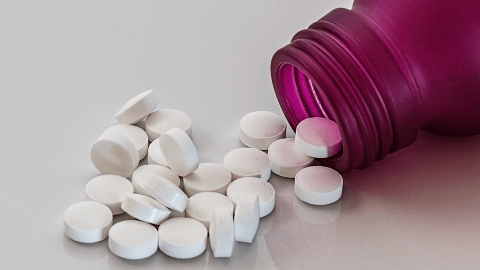预约演示
更新于:2025-05-07
Hyperphenylalaninemia, BH4-Deficient, B
BH4缺乏的B型高苯丙氨酸血症
更新于:2025-05-07
基本信息
别名 GTP - Guanosine-5-triphosphate cyclohydrolase deficiency、GTP CYCLOHYDROLASE I DEFICIENCY、GTP Cyclohydrolase I Deficiency + [16] |
简介 An autosomal recessive condition caused by mutation(s) in the GCH1 gene, encoding GTP cyclohydrolase 1. It is characterized by hyperphenylalaninemia and GTP cyclohydrolase 1-deficient dopa-responsive dystonia. |
关联
1
项与 BH4缺乏的B型高苯丙氨酸血症 相关的药物靶点 |
作用机制 PAH激动剂 |
在研适应症 |
最高研发阶段批准上市 |
首次获批国家/地区 日本 |
首次获批日期1992-03-27 |
6
项与 BH4缺乏的B型高苯丙氨酸血症 相关的临床试验DRKS00019110
Pathophysiology of L-Dopa responsive Dystonia and other monogenetic disorders - PatDyMonDis
开始日期2019-10-25 |
申办/合作机构- |
NCT03655223
Early Check: A Collaborative Innovation to Facilitate Pre-Symptomatic Clinical Trials in Newborns
Early Check provides voluntary screening of newborns for a selected panel of conditions. The study has three main objectives: 1) develop and implement an approach to identify affected infants, 2) address the impact on infants and families who screen positive, and 3) evaluate the Early Check program. The Early Check screening will lead to earlier identification of newborns with rare health conditions in addition to providing important data on the implementation of this model program. Early diagnosis may result in health and development benefits for the newborns. Infants who have newborn screening in North Carolina will be eligible to participate, equating to over 120,000 eligible infants a year. Over 95% of participants are expected to screen negative. Newborns who screen positive and their parents are invited to additional research activities and services. Parents can enroll eligible newborns on the Early Check electronic Research Portal. Screening tests are conducted on residual blood from existing newborn screening dried blood spots. Confirmatory testing is provided free-of-charge for infants who screen positive, and carrier testing is provided to mothers of infants with fragile X. Affected newborns have a physical and developmental evaluation. Their parents have genetic counseling and are invited to participate in surveys and interviews. Ongoing evaluation of the program includes additional parent interviews.
开始日期2018-10-15 |
申办/合作机构 |
DRKS00010150
Investigation of the underlying pathomechanisms found in defects of the neurotransmitter, Pterine -, phenyl alanine, and 5-Methyltetrahydrofolate metabolism in induced pluripotent stem cells (iPSC) and derivatives - PaNeM
开始日期2016-02-10 |
100 项与 BH4缺乏的B型高苯丙氨酸血症 相关的临床结果
登录后查看更多信息
100 项与 BH4缺乏的B型高苯丙氨酸血症 相关的转化医学
登录后查看更多信息
0 项与 BH4缺乏的B型高苯丙氨酸血症 相关的专利(医药)
登录后查看更多信息
121
项与 BH4缺乏的B型高苯丙氨酸血症 相关的文献(医药)2025-02-01·Redox Biology
Tetrahydrobiopterin as a rheostat of cell resistance to oxidant injury
Article
作者: Vasquez-Vivar, Jeannette ; Traeger, R Steven ; Shi, Zhongjie ; Tan, Sidhartha ; Woodcock, James
2024-09-01·Movement Disorders Clinical Practice
Autosomal Recessive Guanosine Triphosphate Cyclohydrolase I Deficiency: Redefining the Phenotypic Spectrum and Outcomes
Review
作者: Bove, Rossella ; Ricciardi, Giacomina ; Novelli, Maria ; Ebrahimi‐Fakhari, Darius ; Pisani, Francesco ; Leuzzi, Vincenzo ; Manti, Filippo ; Quiroz, Vicente ; Yang, Kathryn ; Tolve, Manuela ; Carducci, Claudia ; Galosi, Serena
2024-03-01·Heliyon
Genotype characterization of tetrahydrobiopterin deficiency in two Tibetan children
作者: Yang, Yunxia ; Zhu, Hui ; Zhou, Jiaji ; Luo, Zemin ; Lei, Xunming ; Hu, Qi ; Zeng, Lan ; Zhu, Shuyao ; Ou, Mincai ; Wang, Jin ; Huang, Yu ; Chen, Ai ; Xiong, Fu ; Liu, Jinglin
1
项与 BH4缺乏的B型高苯丙氨酸血症 相关的新闻(医药)2023-07-03
·药通社
据6月29日NMPA发布的一批药品批准证明文件显示,鲁南制药集团山东新时代药业有限公司的盐酸沙丙蝶呤片获批上市(商品名:海普益),斩获该品种国内首仿。此前,国内仅拜马林制药BioMarin International Limited持有的原研制剂-盐酸沙丙蝶呤片(科望)上市,目前其注册证已过期,鲁南制药为国内独家获批上市厂家。
盐酸沙丙蝶呤片是目前治疗高苯丙氨酸血症这一罕见病的唯一药物,适用于对本品治疗有反应的四氢生物蝶呤(BH4)缺乏症所导致的高苯丙氨酸血症(HPA)。该药物原研于2007年由美国食品药品监督管理局批准上市,2011年获得中国国家市场监督管理总局(原中国食品药品监督管理局)的上市批准,该药物30片装售价大概7480元。2022年,该药物院内销售额约900万元。
全国医院销售数据库2021年,北京将其纳入药物报销范围,终身报销60%。去年,拜马林制药宣布,其盐酸沙丙蝶呤片将退出中国市场,原因系国外已有仿制药上市,带来了患者市场的大量流失,从企业整体考量,继续保留该产品线的价值已不大。据药融云数据,原研的盐酸沙丙蝶呤片最新一次再注册为2018年获得批准,有限期至2023年3月21日。此次鲁南制药为盐酸沙丙蝶呤片国内独家获批上市厂家。
疾病概览
2018年5月11日,国家卫生健康委员会等5部门联合制定了《第一批罕见病目录》,高苯丙氨酸血症被收录其中。这是一种基因突变或遗传疾病,患儿无法正常代谢苯丙氨酸,如食用普通食物,体内将大量累积,进而产生高苯丙氨酸血症症状,因此也被称作“不食人间烟火的孩子”。血液中高浓度苯丙氨酸会对中枢神经系统造成不可逆损伤,使患者产生智力低下、自闭症、癫痫、运动障碍等临床症状。如果该病得不到及时治疗,会对患者中枢神经系统造成严重的损伤。
2023年国谈启动,它会进医保吗?
罕见病药退出市场,不罕见,如此前的意大利外企东沛制药的塞奈吉明滴眼液(欧适维)、百傲万里制药的黏多糖贮积症IVA型特效药唯铭赞(Vimizim,依洛硫酸酯酶α)等。退出市场的原因,除了患者数量有限,也于价格有关。百傲万里制药就称“尽管我们在过去几年中尽了最大努力,仍然没有促使唯铭赞进入医保报销体系,我们决定不再续签该产品的进口药品注册证。”
而罕见药进入医保,也不罕见。2022年国家医保药品目录调整,对罕见病用药开通单独申报渠道,支持其优先进入医保药品目录。截至目前,已有45种罕见病用药被纳入国家医保药品目录,覆盖26种罕见病。据国家医保局最新公告,2023年国家医保药品目录调整工作即将启动,明日(2023年7月1日)起开始申报。若盐酸沙丙蝶呤片能“药有所保”,一方面可以提高药物可及性,极大降低患者的负担,提高用药率;另一方面也能加快市场供给,减轻药企和经销商的销售压力。
鲁南药业是否会进行盐酸沙丙蝶呤片的申报,又是否会顺利纳入医保?我们拭目以待。
网参考资料:
1.药融云数据库
2.财经大健康:这款罕见病药即将退出中国市场,患者面临断药危机
内容来源于网络,如有侵权,请联系删除。

上市批准
分析
对领域进行一次全面的分析。
登录
或

生物医药百科问答
全新生物医药AI Agent 覆盖科研全链路,让突破性发现快人一步
立即开始免费试用!
智慧芽新药情报库是智慧芽专为生命科学人士构建的基于AI的创新药情报平台,助您全方位提升您的研发与决策效率。
立即开始数据试用!
智慧芽新药库数据也通过智慧芽数据服务平台,以API或者数据包形式对外开放,助您更加充分利用智慧芽新药情报信息。
生物序列数据库
生物药研发创新
免费使用
化学结构数据库
小分子化药研发创新
免费使用


